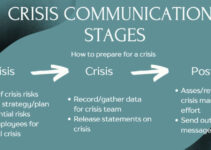Starbucks is the world’s leading retail chain coffeehouse American multinational brand. The chain coffeehouse brand has established a strong position of providing a comfortable place where customers can come, relax, and enjoy coffee with their friends. A video went viral over social media in 2018 about the Starbucks coffeehouse in Philadelphia; it surprised people about the racist attitude of the company’s employees towards some visitors. Today, we’ll discuss Starbucks crisis management; the crisis event that went viral over social media; the strategic approach of the company, and lessons learned from the crisis event.
Crisis Event at Starbucks
A video went viral in 2018 highlighting the arrest of two men at the Starbucks coffeehouse chain store in Philadelphia. The whole incident started when a black man wanted to use the restroom while waiting for a friend, but the company’s security guard didn’t give him permission. However, the situation escalated when the coffeehouse store manager called the police that two men were trespassing the store; Starbucks crisis management.
The video clearly highlighted the discriminatory and racist attitude of the company’s employees and managers. Starbucks already had a policy of allowing non-paying visitors to use the company’s restroom. The judgmental attitude of the store manager and security guard in deciding who should use the store’s restroom and who shouldn’t.
Impact of the Crisis Event
The video had a great impact after going viral and it resulted in the form of mass public backlash and disgust towards the company. Many people voted to boycott Starbucks; protests and social media memes greatly jeopardized the company’s longstanding reputation. However, it compelled the company to take the necessary steps to deal with the crisis situation.
Strategic Approach to Starbucks Crisis Management
Let’s discuss some of the main strategic approaches and steps of Starbucks crisis management to deal with the situation and they’re as follows;
Immediate Course of Action
The CEO of Starbucks, Kevin Johnson publically apologized to the victims of the racial incident and showed their deepest remorse and regrets to the whole event. The company’s CEO took this step within 24 hours of the event happening. However, he immediately ordered the full closure of Starbucks 8000 stores across the US. He made it mandatory for all employees to participate in the racial bias and discrimination training programs. He showed a strong commitment to resolving the issue by taking necessary and important steps to avoid such events in the future.
Multiple Media Channels
In order to promote Starbucks’ apology and diversity message among the mass public audience; the coffeehouse chain store brand employed multiple media channels. The company updated its social media policy of proactively engaging with customers and answering their questions, comments, reviews, and feedback.
Along with social media interviews, posting, and user engagement; Starbucks also issued a press release, the company’s official statement towards the event on traditional media channels. The company showed its full support and commitment to the event and remains consistent with its message on multiple media channels.
Inclusive & Diversity Training Programs
Starbucks acknowledged the existing racial discrimination element among some of its employees and team members. As soon as the crisis incident happened, Starbucks introduced racial bias awareness training programs to make people more aware of their actions to avoid such incidents from happening again.
However, the coffeehouse chain brand closed its 8000 stores across the country and ordered approximately 175000 employees to participate in the training program. The focus of the training program is to develop an empathic attitude and recognize unconscious biases among employees and team members.
Updating Starbucks’ Policies
Along with conducting employee training programs, Starbucks revised and updated its policy and put emphasis on diversity and inclusive elements. The revised policy “3rd Place Policy” made it perfectly clear to all the customers and visitors that they could use the company’s restroom whenever they wanted. The clarification of the company’s policy helped the company to develop a more inclusive environment for all types of customers and users.
However, the objective of the training program was to build an inclusive and welcoming working culture for all the employees and customers. It helped the company to avoid the occurrence of racial discrimination incidents.
Rebuilding Trust Campaign
In order to rebuild the trust and confidence of customers, Starbucks developed a long-term strategic campaign to restore the company’s values and actions. The company started organizing local social events, connecting and engaging with the community members to earn their trust and confidence. However, active participation in the local social events highlighted the company’s commitment to social responsibility.
Lessons Learned from Starbucks Crisis Management
Some of the main lessons learned from the Starbucks crisis management event and the company’s strategic steps are as follows;
- Proactively getting ready for the crisis event and effectively responding to it
- Open and transparent communication with the public
- Conducting employees’ training programs to make them more aware
- Revising the company’s policy to avoid any type of ambiguity and loophole
Conclusion: Strategic Crisis Management of Starbucks
After an in-depth study of the Starbucks crisis management; we have realized that Starbucks is the world’s leading retail coffeehouse chain store brand. If you are learning about the case study of the crisis management of Starbucks; then you should keep in mind the abovementioned crisis event; the company’s strategic approach, and lessons learned from the event.
Ahsan is an accomplished researcher and has a deep insight in worldly life affairs. He goes Live 3 days a week on various social media platforms. Other than research writing, he’s a very interesting person.


